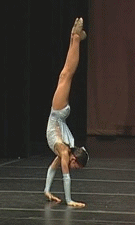Hand walking
Hand walking is a form of acrobatics and body coordination in which an individual moves forward or backward while balanced on their hands. This skill is often associated with gymnastics, circus arts, and breakdancing, showcasing the performer's strength, balance, and control. Hand walking can be performed as a standalone act or incorporated into routines, including dance, martial arts, and various physical fitness regimens.
History[edit | edit source]
The origins of hand walking are difficult to pinpoint, as the skill has been a part of various cultures' acrobatic and circus traditions for centuries. It likely evolved from the human fascination with balance and body control, as well as the desire to perform extraordinary physical feats. In the modern era, hand walking has been popularized by both circus performers and athletes, particularly within the gymnastics community, where it is both a training exercise and a competitive discipline.
Technique[edit | edit source]
Mastering hand walking requires significant practice, strength, especially in the arms and shoulders, and balance. The basic technique involves:
- Starting in a handstand position, with the arms straight and the body fully extended.
- Shifting weight slightly to one hand while moving the opposite hand forward.
- Repeating the process with the other hand, effectively "walking" on the hands.
Advanced practitioners can perform variations, such as changing direction, increasing speed, or incorporating tricks like spins or flips.
Training[edit | edit source]
Training for hand walking typically begins with building the necessary upper body strength and balance. This often includes exercises such as push-ups, handstand holds against a wall, and gradually moving to freestanding handstands. Flexibility, particularly in the wrists, is also crucial for reducing the risk of injury. Many athletes use spotting from a coach or partner when first learning to walk on their hands to ensure safety and proper form.
Applications and Benefits[edit | edit source]
Beyond its visual appeal, hand walking offers several physical benefits, including improved upper body strength, core stability, balance, and coordination. It is also used as a training tool in various sports and disciplines to enhance body control and spatial awareness.
In Popular Culture[edit | edit source]
Hand walking has been featured in numerous films, television shows, and music videos, often to highlight a character's acrobatic skill or physical prowess. It is also a popular challenge on social media platforms, where individuals showcase their abilities and progress.
See Also[edit | edit source]
Search WikiMD
Ad.Tired of being Overweight? Try W8MD's physician weight loss program.
Semaglutide (Ozempic / Wegovy and Tirzepatide (Mounjaro / Zepbound) available.
Advertise on WikiMD
|
WikiMD's Wellness Encyclopedia |
| Let Food Be Thy Medicine Medicine Thy Food - Hippocrates |
Translate this page: - East Asian
中文,
日本,
한국어,
South Asian
हिन्दी,
தமிழ்,
తెలుగు,
Urdu,
ಕನ್ನಡ,
Southeast Asian
Indonesian,
Vietnamese,
Thai,
မြန်မာဘာသာ,
বাংলা
European
español,
Deutsch,
français,
Greek,
português do Brasil,
polski,
română,
русский,
Nederlands,
norsk,
svenska,
suomi,
Italian
Middle Eastern & African
عربى,
Turkish,
Persian,
Hebrew,
Afrikaans,
isiZulu,
Kiswahili,
Other
Bulgarian,
Hungarian,
Czech,
Swedish,
മലയാളം,
मराठी,
ਪੰਜਾਬੀ,
ગુજરાતી,
Portuguese,
Ukrainian
Medical Disclaimer: WikiMD is not a substitute for professional medical advice. The information on WikiMD is provided as an information resource only, may be incorrect, outdated or misleading, and is not to be used or relied on for any diagnostic or treatment purposes. Please consult your health care provider before making any healthcare decisions or for guidance about a specific medical condition. WikiMD expressly disclaims responsibility, and shall have no liability, for any damages, loss, injury, or liability whatsoever suffered as a result of your reliance on the information contained in this site. By visiting this site you agree to the foregoing terms and conditions, which may from time to time be changed or supplemented by WikiMD. If you do not agree to the foregoing terms and conditions, you should not enter or use this site. See full disclaimer.
Credits:Most images are courtesy of Wikimedia commons, and templates, categories Wikipedia, licensed under CC BY SA or similar.
Contributors: Prab R. Tumpati, MD

